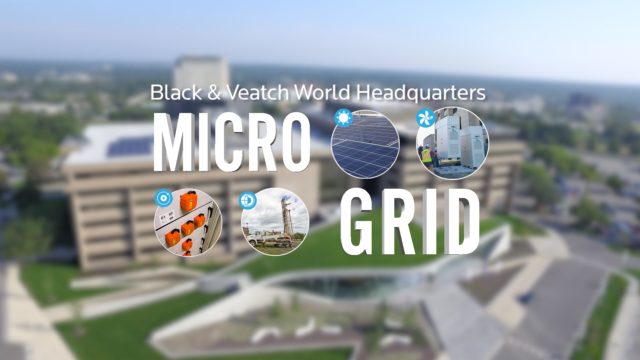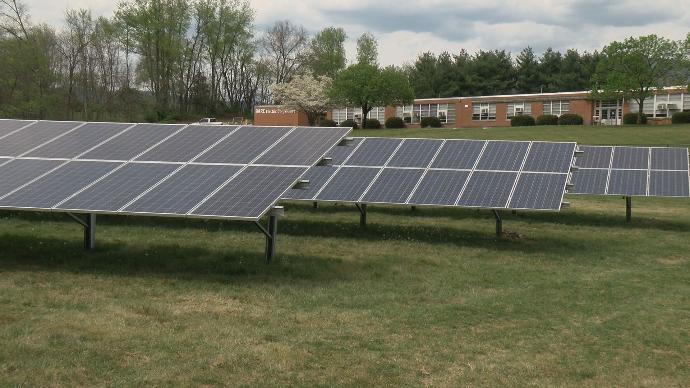Microgrids

– Black & Veatch Wins Gold Edison Award for Corporate Campus Microgrid
Black & Veatch’s microgrid draws on a natural gas-fired microturbine, a solar PV array, a geothermal heating/cooling system and smart Li-ion battery storage to power the 12,000 square foot Rodman Innovation Pavilion located on the industrial engineering corporation’s headquarters near Overland Park, Kansas.
In addition to providing an independent source of clean energy, Ed Walsh, president of Black & Veatch’s Power Business, highlighted the role the microgrid is playing in terms of employee education, training, and enhancing the company’s competitiveness. The microgrid, he explained, “provides a tangible training and education asset to better show the role of microgrids and how they can benefit clients around the world. This recognition from Edison further points to the importance of innovation and validates the continued need for greater energy efficiency.”
– Mid-Atlantic Microgrid Business Partnership
Blunt Group, DirectSun Solar. and Grid Development Partners launched a special-purpose entity (SPE) via which they aim to deploy microgrids in Washington DC, Maryland, and Virginia.
The partners view the microgrid SPE as a means of fostering greater use of distributed, local renewable energy resources and enhancing grid security, reliability. and resilience. They intend to employ business models ¨to increase community participation in the new energy economy and save consumers money by developing community energy cooperatives,¨ according to a news release.
“This innovative partnership in collaboration with utilities, governments, and education administrations at all levels will focus on training the new energy workforce for sustainable higher paying jobs, creating new and advanced manufacturing jobs as well as sustainable employment by increasing trade with emerging markets in the Americas, Asia, and Africa,” said BG and GDP chairman Roger Blunt.
– Aquion Energy, Ideal Power Supply Microgrid at Sonoma Winery
Stone Edge Farm’s microgrid relies on a combination of solar PV and intelligent battery energy storage to supply emissions- and water-free electricity for its 16-acre organic winery in Sonoma County, north of San Francisco.
The platform includes 14 of Aquion’s 25 kWh M-line of Aqueous Hybrid Ion (AHI) batteries and energy storage systems, which are expected to provide about 350 kWh of energy storage capacity. The system will store and dispatch electricity produced by a 32 kW solar PV array using Ideal Power’s 30 kW multi-port power conversion system.
In addition to supplying power for winery facilities, the microgrid, developed by Wooster Engineering Specialties, shaves peak power loads and shifts loads so as to reduce electricity consumption and bills as well as emissions.
The system is generating surplus electricity, which Stone Edge sells and dispatches for use on local utility provider Pacific Gas & Electric’s grid, according to the news report.
International
– Caterpillar Looks to Install Hybrid Microgrids in Africa
The multinational agricultural and construction manufacturer unveiled its hybrid microgrid systems at an event in Tucson, Arizona, the last week in April. Ranging from 10 kW all the way up to 100MW, Caterpillar’s hybrid microgrid platforms combine solar PV, diesel gensets, and battery energy storage.
The pilot-testing installation Caterpillar has built in the Sonoran Desert consists of 500kW of PV panels, a 500kW battery energy storage system, and three C15 410kW diesel generator sets.
Tempe-based solar PV OEM First Solar is supplying Caterpillar-branded thin-film solar panels as part of a strategic partnership between the two companies signed in 2015. Thin-film PV panels are better suited for high-temperature and high humidity environments found in desert, coastal, and tropical environments.
Caterpillar’s microgrid platform includes several energy storage options, including Fluidic Energy’s rechargeable metal-air battery storage technology. They can also make use of lithium-ion battery systems and/or ultracapacitors.
Caterpillar has an equity stake in Fluidic Energy, which uses materials with no resale value in manufacturing its metal-air batteries. That’s an attraction for prospective customers, especially those in rural areas where solar PV and battery energy storage systems have proven attractive to thieves.
Real- or near-real-time data communications between the microgrids and CAT Connect, the multinational’s data processing center, provide remote monitoring, operational support, and data analytics that optimize systems performance and the value customers derive, Caterpillar states.
Community Solar

*BARC Electric Cooperative
– Virginia Readies Launch of First Community Solar Coop
Some 1,300 solar PV panels have been installed on the site of BARC Electric Cooperative’s community-owned solar project site in Rockbridge County. Governor Terry McAuliffe is to ¨flip the switch¨ and bring the solar power system online in June, according to a news report.
Project development is ahead of schedule. “It looks like it went up overnight, and it almost did. Once they put the mounts in place, the panels just went up very quickly,” BARC’s Dave Clinton explains.
The community-owned solar power farm is expected to produce 550 kW of emissions-free electrical power for some 200 customer-subscribers. The project is currently 75% subscribed, and BARC expects it will be 100% subscribed come the June launch.
– Community Solar Project Comes Online in Southeast Texas
U.S. Congressman Ken Brady cut the ribbon and commissioned a community solar power project in the Grimes County town of Bedias. Developed by Mid-South Synergy, the community solar power farm is one of the few in southeast Texas, according to an April 25 KBTX news report.
Members of Mid-South Synergy co-op can purchase emissions-free electricity and lock in prices for five years. Mid-South’s Eric Hughes highlighted the potential of community solar power projects to broaden access to sustainable solar energy resources. “There’s only a certain number of homes that even qualify to put solar on your roof,¨ he says, “given trees, shade, the pitch of the roof, that sort of thing. So this [provides] a maintenance-free option.”
Clean Energy Policy & Markets

*SEIA
– Energy Department Joins in Celebrating 1 Million Solar Roofs
Reaching the 1 million solar roofs milestone is a ¨product of American innovation and ingenuity,¨ the Department of Energy (DOE) states. Solar Energy Industries Association’s (SEIA) Million Solar Strong, a public relations campaign that includes a week-long series of solar industry events celebrating installation of 1 million solar energy roofs in the U.S. Million Solar Strong kicks off this week.
Reaching the milestone ¨is the result of consumers, policy leaders, advocates and an industry of over 200,000 workers who have all helped make the nation’s clean energy revolution a reality,¨ DOE states.
– Senate Passes Bill that Supports Grid-Connected and Hybrid Microgrids
Approved in an 85-12 vote, the Energy Policy Modernization Act of 2016 is the first major energy bill the Senate has passed in nearly a decade, according to a Microgrid Knowledge news report.
Among several other significant items, the legislation call for federally regulated Regional Transmission Organizations (RTOs) to collect data from microgrids and other forms of distributed energy in their service territories. These include microgrids and DERs that dispatch electricity to power grids, their fuel sources, operational characteristics, costs, and benefits. The proposed bill, which now proceeds to committee, also calls on RTOs to identify barriers to microgrid deployment.
– Solar PV Required on All New Low-Rise Buildings in San Francisco as of 2017
A new law requiring solar PV on all new low-rises applies to all new buildings of 10 stories or less beginning January 2017. With San Francisco planning to rely entirely on renewable energy by 2020, this measure goes well beyond a California law that requires that solar PV panels cover at least 15% all new buildings.
The new law may also allow building owners to install ¨living roofs¨ as an alternative. ¨Living roofs would be insulating, serve as wildlife habitats, and help handle excess stormwater,¨ City Supervisor Scott Weiner explained in Digital Trends‘ news report. “This legislation will activate our roofs, which are an under-utilised urban resource, to make our city more sustainable and our air cleaner.”
